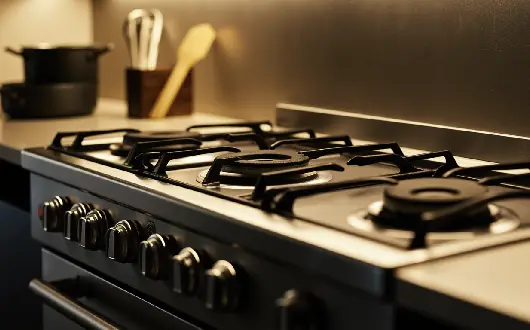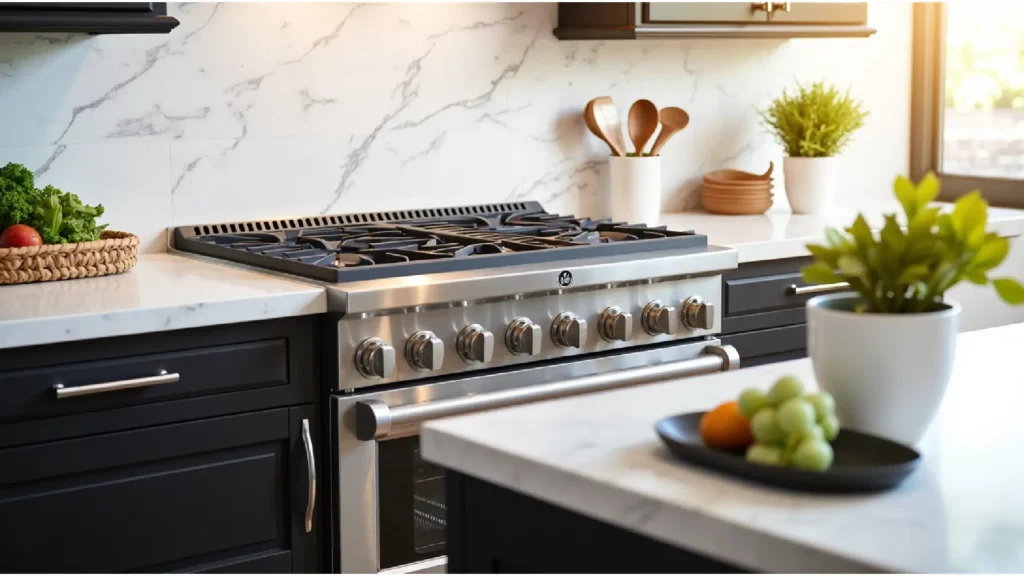
Efficient Venting: Gas Cooktop Downdraft Vent Solutions
When it comes to cooking, we often focus on the ingredients, the recipes, and maybe even the kitchen gadgets that make our lives easier. But have you ever thought about the air quality in your kitchen? Efficient venting is crucial, not just for keeping your kitchen smelling fresh, but also for maintaining a healthy environment.
You might not realize it, but cooking can release a lot of smoke, steam, and even harmful gases. If you don’t have a good venting system in place, all those particles can linger in the air, making it less than pleasant to whip up your favorite meals. On top of that, poor ventilation can lead to grease buildup on your walls and cabinets.
Trust me, nobody wants to spend their weekends scrubbing away at greasy surfaces. Plus, if you’re using gas for cooking, there’s the added concern of carbon monoxide. It’s a colorless, odorless gas that can be dangerous in high concentrations.
So, having an efficient venting system isn’t just about comfort; it’s about safety too. You want to create a space where you can cook without worrying about what’s floating around in the air.
Key Takeaways
- Efficient venting is crucial for maintaining air quality and removing cooking odors and pollutants from the kitchen.
- Gas cooktop downdraft solutions offer advantages such as space-saving design, effective ventilation, and sleek aesthetics.
- When choosing a gas cooktop downdraft system, consider factors such as the size of the cooktop, the power of the ventilation system, and the ease of maintenance.
- Proper installation and regular maintenance are essential for ensuring the efficient operation of gas cooktop downdraft solutions.
- Different gas cooktop downdraft systems vary in terms of design, power, and features, so it’s important to compare them to find the best fit for your kitchen.
Advantages of Gas Cooktop Downdraft Solutions
Now, let’s dive into gas cooktop downdraft solutions. If you’re considering a new cooktop or just looking to upgrade your current setup, you might want to think about this option. One of the biggest advantages is that downdraft systems pull smoke and odors down and out of your kitchen instead of pushing them up into the air.
This can be especially helpful if you have low ceilings or if your kitchen doesn’t have a lot of overhead space for traditional hoods. What’s interesting is that downdraft systems can be quite sleek and modern-looking. They often integrate seamlessly into the cooktop itself, which means you don’t have to sacrifice style for functionality.
Plus, they can be easier to clean than traditional hoods since there are fewer nooks and crannies for grease to hide in. And let’s be honest—who doesn’t appreciate a little extra ease when it comes to cleaning up after a big meal?
Factors to Consider when Choosing a Gas Cooktop Downdraft System
When you’re on the hunt for a gas cooktop downdraft system, there are a few key factors to keep in mind. First off, think about the size of your kitchen and how much cooking you actually do. If you’re someone who loves to entertain or cook elaborate meals, you’ll want a system that can handle higher volumes of smoke and steam.
Look for models with higher CFM (cubic feet per minute) ratings; this indicates how much air the system can move. Another thing to consider is noise level. Some downdraft systems can be pretty loud when they’re running at full blast.
If you’re like me and enjoy chatting with friends while cooking, you might want to opt for a quieter model. And don’t forget about installation requirements! Some systems might need more complex setups than others, so it’s worth checking if you’ll need professional help or if it’s something you can tackle yourself.
Installation and Maintenance of Gas Cooktop Downdraft Solutions
| Metrics | Value |
|---|---|
| Installation Time | 2-4 hours |
| Maintenance Frequency | Every 6 months |
| Replacement Parts Cost | 50-100 |
| Service Life | 10-15 years |
Installing a gas cooktop downdraft system can be a bit tricky, especially if you’re not super handy around the house. It usually involves some plumbing and electrical work, so unless you’re comfortable with that kind of stuff, it might be best to call in a pro. But if you’re up for the challenge, just make sure to follow the manufacturer’s instructions closely.
It’s always better to double-check than to end up with a system that doesn’t work properly. Once it’s installed, maintenance is pretty straightforward. Regularly cleaning the filters is essential; otherwise, they can get clogged and reduce efficiency.
Most systems come with removable filters that you can wash or replace easily. And while you’re at it, give the cooktop itself a good wipe-down every now and then to keep everything looking fresh. It’s those little maintenance tasks that can make a big difference in how well your downdraft system performs over time.
Comparison of Different Gas Cooktop Downdraft Systems
There are quite a few options out there when it comes to gas cooktop downdraft systems, and each has its own set of features and benefits. For instance, some models come with built-in lighting, which can be super handy when you’re cooking late at night or in dim lighting. Others might offer multiple fan speeds so you can adjust based on what you’re cooking—think simmering sauces versus searing steaks.
Then there are brands that are known for their reliability and performance. You might want to check out reviews or ask friends for recommendations before making a decision. It’s also worth considering your budget; some systems can get pretty pricey, but there are also more affordable options that still do a great job.
Just remember that investing in a quality downdraft system can save you money in the long run by improving air quality and reducing cleaning time.
Maximizing the Effectiveness of Venting in Your Kitchen
To really get the most out of your gas cooktop downdraft system, there are some tips and tricks you can follow. First off, always turn on your venting system before you start cooking. This helps capture smoke and odors right from the get-go instead of letting them build up in your kitchen.
It might seem like a small thing, but trust me—it makes a difference. Another thing to consider is the layout of your kitchen. If possible, position your cooktop near windows or doors that can help with cross-ventilation.
Opening a window while cooking can really help clear out any lingering smells or smoke. And don’t forget about using lids on pots and pans when appropriate; this not only helps with cooking but also minimizes steam escaping into the air.
Troubleshooting Common Issues with Gas Cooktop Downdraft Systems
https://www.youtube.com/embed/eur-RePNxLk
Even with the best systems out there, issues can pop up from time to time. One common problem is reduced airflow; if you notice that your downdraft isn’t pulling air as effectively as it used to, check the filters first. Clogged filters are often the culprit and can easily be cleaned or replaced.
Another issue could be noise levels increasing unexpectedly. If your downdraft suddenly sounds like a jet engine taking off, it might be time for some maintenance or even a check-up by a professional. Sometimes, loose parts or debris can cause rattling noises that are easy to fix but annoying nonetheless.
Future Trends in Gas Cooktop Downdraft Venting Solutions
Looking ahead, it’s exciting to think about where gas cooktop downdraft venting solutions are headed. With technology advancing so quickly, we might see more smart features integrated into these systems—think app-controlled settings or sensors that automatically adjust fan speed based on cooking conditions. Sustainability is also becoming more important in home appliances, so we might see more energy-efficient models hitting the market soon.
It’ll be interesting to see how manufacturers balance performance with eco-friendliness while still keeping things stylish and functional. In conclusion, investing in an efficient gas cooktop downdraft system is definitely worth considering if you’re serious about cooking and maintaining a pleasant kitchen environment. With so many options available today, you’re bound to find one that fits your needs perfectly!
If you are considering purchasing a gas cooktop with a downdraft vent, you may also be interested in learning about the benefits of a 36-inch gas cooktop with downdraft. This article from gas-cooktop.com provides valuable information on the advantages of a larger cooktop size and how it can enhance your cooking experience. Additionally, if you are looking for a high-quality gas cooktop, you may want to check out the Thor Gas Cooktop. This article from gas-cooktop.com highlights the features and performance of this top-rated cooktop brand.
FAQs
What is a gas cooktop downdraft vent?
A gas cooktop downdraft vent is a ventilation system that is built into the cooktop itself, allowing for the removal of smoke, steam, and cooking odors directly from the cooking surface.
How does a gas cooktop downdraft vent work?
A gas cooktop downdraft vent works by drawing in the cooking byproducts through vents located on the cooking surface and then directing them downward through a duct system, ultimately expelling them outside the home.
What are the benefits of a gas cooktop downdraft vent?
Some benefits of a gas cooktop downdraft vent include its space-saving design, as it eliminates the need for a separate overhead hood, and its ability to efficiently remove cooking byproducts at the source.
Are there any drawbacks to using a gas cooktop downdraft vent?
One potential drawback of a gas cooktop downdraft vent is that it may not be as effective at capturing cooking byproducts as a traditional overhead hood, especially when cooking with high heat or large amounts of steam.
Can a gas cooktop downdraft vent be installed in any kitchen?
Gas cooktop downdraft vents can be installed in most kitchens, but it is important to consider the layout and ventilation needs of the space before making a decision. Professional installation may be required in some cases.




